A dipole is placed in an electric field as shown. In which direction will it move
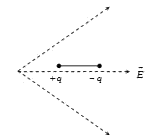
Towards the right as its potential energy will decrease
Towards the left as its potential energy will decrease
Towards the right as its potential energy will increase
Towards the left as its potential energy will increase
The correct Answer is:A
Towards the right as its potential energy will decrease. |E1|>|E2| as filed lines are closer at charge +q, so net Force on the dipole acts towards right side. A system always moves to decrease it’s potential energy.
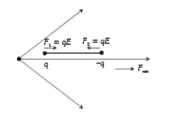
Topper's Solved these Questions
- BOOK - ERRORLESSCHAPTER - ELECTROSTATICSEXERCISE - ASSERTION & REASON25videos
ELECTROSTATICS
- BOOK - ERRORLESSCHAPTER - ELECTROSTATICSEXERCISE - NCERT BASED QUESTIONS (Grouping of Capacitors)58videos
ELECTROSTATICS
- BOOK - ERRORLESSCHAPTER - ELECTRONICSEXERCISE - Assertion & Reason26videos
ELECTRONICS
- BOOK - ERRORLESSCHAPTER - MAGNETIC EFFECTS OF CURRENT EXERCISE - ASSERTION & REASON18videos
MAGNETIC EFFECTS OF CURRENT
Similar Questions
A dipole is placed in an electric field as shown. In which directions will it move?
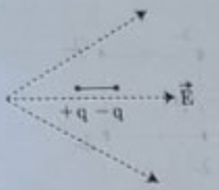 View Solution
View SolutionA dipole is placed in constant electric field E as shown . If it is released from rest this position find the kinetic energy gained when it is parallel to electric field vector .
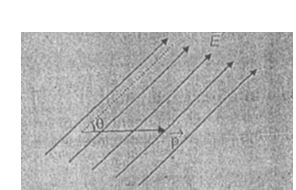
( Assume dipole is small and placed in a gravity free space ) .View Solution
Knowledge Check
- Question 1 - Select One
When an electric dipole is placed in a uniform electric field, a couple acts on it. The moment of couple will be maximum when the dipole is placed
AAlong the fieldBPerpendicular to the fieldCAgainst the fieldDAt 45∘ to the field - Question 2 - Select One
An electric dipole is placed in a non uniform electric field increasing along the +ve direction of " X-axis " .In which direction does the dipole
 Amove along +ve direction of "X-axis", rotate clockwiseBmove along −ve direction of "X-axis" ,rotate clockwiseCmove along +ve direction of "X-axis" ,rotate anti clockwiseDmove along −ve direction of "X-axis" ,rotate anti clockwise
Amove along +ve direction of "X-axis", rotate clockwiseBmove along −ve direction of "X-axis" ,rotate clockwiseCmove along +ve direction of "X-axis" ,rotate anti clockwiseDmove along −ve direction of "X-axis" ,rotate anti clockwise - Question 3 - Select One or More
An electric dipole is placed in uniform electric field. The magnitude of electric dipole moment of dipole is p and external electric field intensity is E. Asume θ is the angle between electric dipole moment and electric field intensity and U represents potential energy of electric dipole
AIf U=0 for θ=0 then for other orientations U=pE(1−cosθ)BIf U=0 for θ=90∘ then for other orientations U=−pEcosθCIf U=0 for θ=180∘ then for other orientations U=−pE(1+cosθ)DAll of the above
An electric dipole is placed in an electric field. Column I is the description of electric field and the angle between the dipole moment →p and the electric field intensity →E and Column II gives the effect of the field on the dipole. Then,
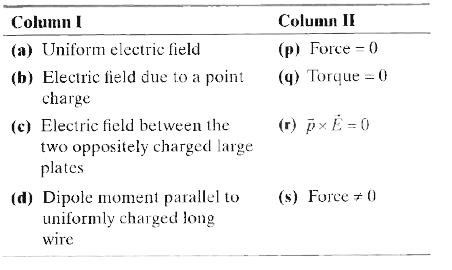 View Solution
View SolutionAn electric dipole is placed in a uni8form electric field.
View SolutionAn electric dipole is placed in a uniform electric field. The dipole will experience
View SolutionAn electric dipole is placed at rest in a uniform electric field, and released. How will it move ?
View SolutionThere exists a non!-uniform electric field along x-axis as shown in the figure below. The field increases at a uniform rate along +ve x-axis. A dipole is placed inside the field as shown. Which one of the following is correct for the dipole?
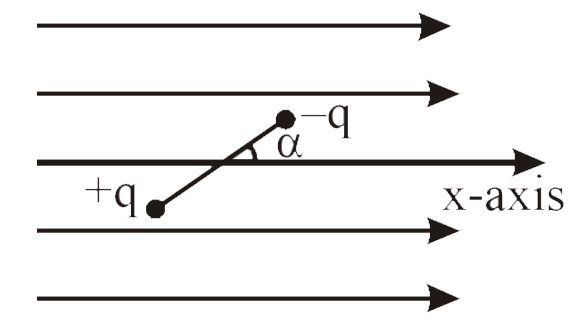 View Solution
View Solution

